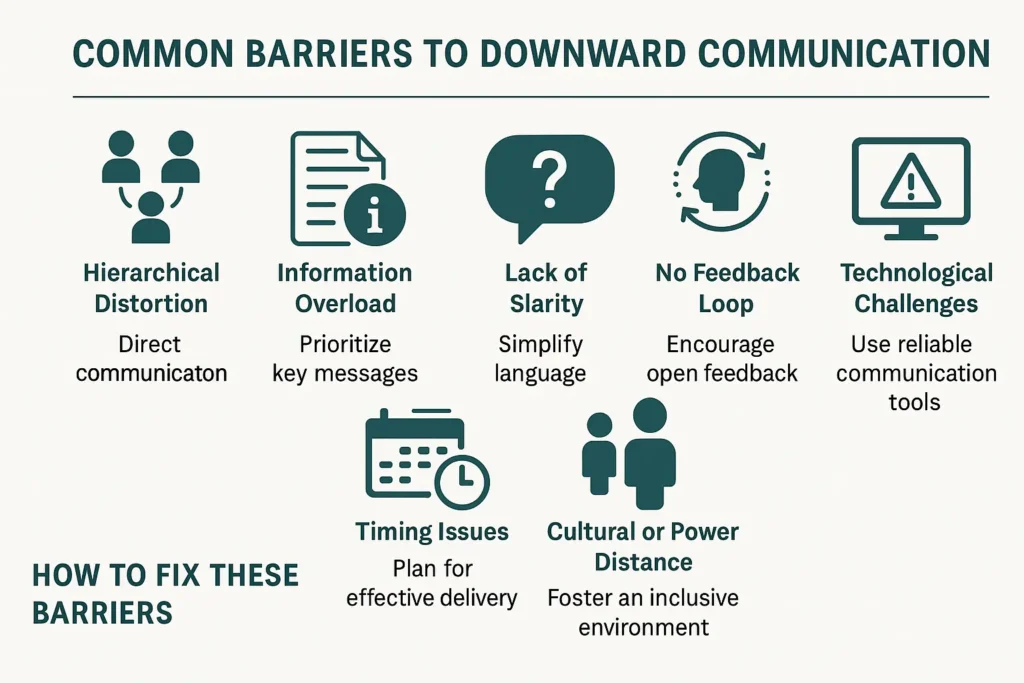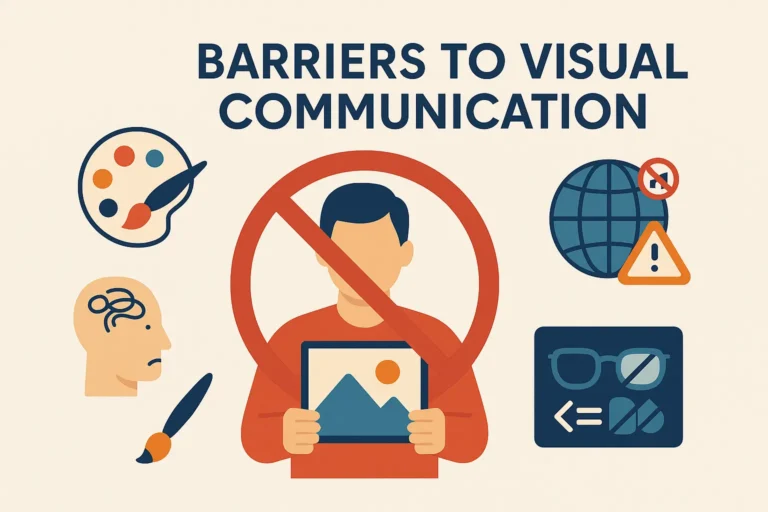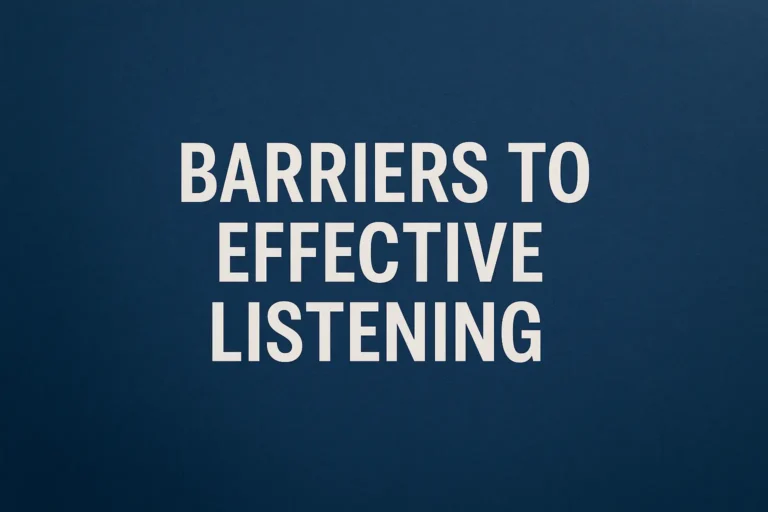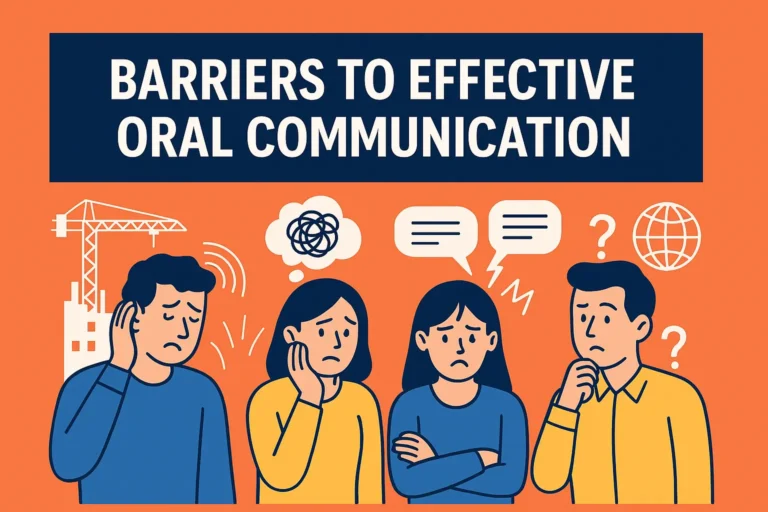Barriers of Downward Communication
What Is Downward Communication?
Downward communication is the flow of information from higher levels of an organization to lower levels. This includes directions, policies, feedback, and decisions shared from management to staff.
Why It Matters
- Provides direction: Helps employees understand their roles and expectations.
- Aligns teams: Ensures everyone is working toward the same goals.
- Builds structure: Keeps processes running smoothly through shared policies and procedures.
When done well, downward communication supports productivity and clarity. When done poorly, it creates noise, confusion, and disconnect.
Common Barriers to Downward Communication
Even experienced leaders can encounter roadblocks when sending messages down the chain. These are some of the most frequent challenges:

Organizational Structure and Hierarchy
Complex organizational charts create too many layers. As messages pass through each level, details can be lost or altered. This distortion—often called message filtering—makes instructions unclear by the time they reach employees.
Example: A message sent by the CEO might reach a front-line employee with missing or changed details due to intermediate managers adding their own interpretations.
Information Overload
Dumping too much information on employees at once leads to overwhelm. When people are unsure what to prioritize, important details may be ignored.
Timing matters too. Delivering non-urgent messages during high-pressure periods can cause employees to miss or skim through them.
Lack of Clarity and Structure
Vague, wordy, or unstructured messages are hard to follow. Using technical language or jargon without explanation creates semantic barriers—especially for diverse teams.
Fix: Break information into clear sections. Use bullet points and summarize action steps. Avoid overusing acronyms and buzzwords.
Limited Feedback Loop
Downward communication is often one-way. Without encouraging feedback, leaders can’t confirm that employees understood or felt confident about what they heard.
Solution: Invite clarification. Use tools like anonymous surveys, check-ins, or brief follow-up sessions.
Technological Challenges
Outdated or fragmented systems make messages easy to miss. A poorly designed intranet, glitchy emails, or excessive Slack notifications can interrupt message flow.
Tip: Invest in reliable tools. Use a unified platform and avoid sending critical messages through scattered channels.
Cultural and Power Distance
In some cultures or workplaces, employees may hesitate to speak up. This “power gap” means workers may not ask questions, even if instructions are unclear.
Example: A new hire from a high power-distance culture may remain silent in a meeting rather than request clarification.
How These Barriers Affect Your Workplace
The impact of poor downward communication extends beyond a few missed messages. It affects team performance and culture:
- Decreased morale: Confused employees feel left out and undervalued.
- Mistakes and rework: Vague directions lead to errors and delays.
- Low productivity: Teams waste time figuring out unclear tasks.
- Broken trust: Inconsistent or misleading messages damage credibility.
How to Improve Downward Communication
Improving how you communicate with your team starts with awareness and practical action. Here’s how to reduce barriers:
Create a Clear Communication Structure
Decide what channels to use for which types of messages:
- Email: formal updates, policy changes
- Slack/Teams: reminders or casual notes
- Meetings: announcements, feedback
Use templates or message formats for recurring communication.
Train Managers and Middle Leaders
Middle managers are key messengers. Equip them with skills to deliver clear, respectful, and timely communication.
Topics to cover:
- Clarity and tone
- Avoiding information overload
- Cultural sensitivity
Encourage and Reward Feedback
Make it normal to ask questions and suggest improvements. Use polls, anonymous forms, or quick feedback rounds after key announcements.
When employees feel heard, they’re more likely to act confidently.
Simplify the Message
Avoid overcomplicating. Ask yourself:
- What is the core message?
- Is anything repetitive?
- Does every sentence support the main point?
Tools like Grammarly’s Clarity Assistant help keep writing sharp and easy to understand.
Make Communication Inclusive
Use plain language, add visuals when possible, and double-check for cultural nuances. Offer translated versions or recordings where needed.
External Source: RW-3 CultureWizard on Cross-Cultural Communication
Provide Timely Updates and Recaps
Don’t wait too long to deliver important updates. Also, provide a quick recap or follow-up so teams can refer back easily.
Example: After a town hall meeting, send a one-page summary with bullet points, links, and next steps.
The Role of Feedback in Downward Communication
Effective downward communication isn’t truly effective unless it sparks feedback. One-way directives are prone to misinterpretation.
Use this checklist:
- Did I invite questions?
- Is there a follow-up step?
- Can employees respond easily?
Feedback transforms a broadcast into a conversation.
Conclusion: Strong Messages Build Strong Teams
When you remove barriers to downward communication, you unlock better performance, more trust, and clearer expectations. It starts with structure, training, simplicity, and openness.
The focus should be on ensuring your team hears—not just receives—what you’re trying to say. With the right steps, leaders can send messages that stick, empower teams, and support lasting success.
For more on related challenges, check out our guide on Sender Barriers to Communication.






